We may not have the course you’re looking for. If you enquire or give us a call on +44 1344 203999 and speak to our training experts, we may still be able to help with your training requirements.
Training Outcomes Within Your Budget!
We ensure quality, budget-alignment, and timely delivery by our expert instructors.
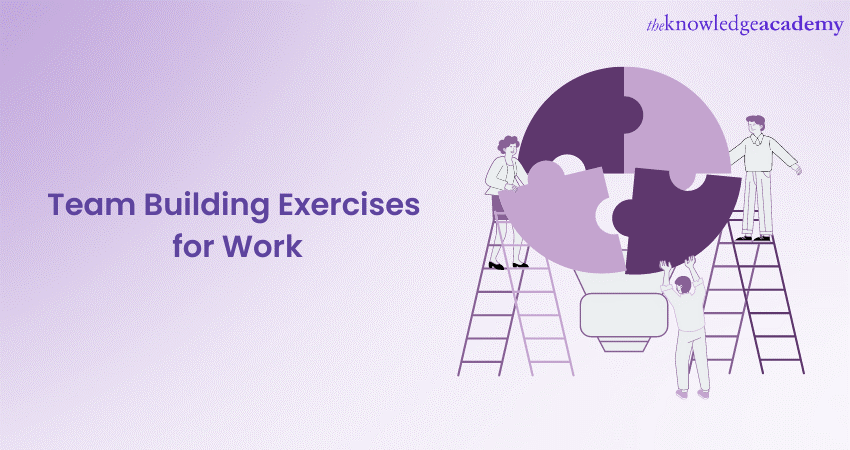
With the pandemic hitting the world, everybody was restricted to work from their homes. They learnt to work in a team on virtual platforms. However, to make the employees feel connected and regain the old comraderies between members, many organisations practised best Team Building Exercises, which are still prevalent after the pandemic.
The reason for carrying out the best Team Building Exercises at work is to increase effective communication. In this blog, we will learn about different exercises for Team Building, how they help create thriving and harmonious teams and encourage cooperation and bonding.
Table of Contents
1) Why are Team Building Exercises necessary?
2) What are the types of Team Building Exercises?
a) Ice breaker exercises
b) Communication exercises
c) Problem solving exercises
d) Trust building exercises
e) Fun and engaging exercises
3) Conclusion
Why are Team Building Exercises necessary?
Team Building Exercises are not just recreational activities; they are a pivotal part of a company's strategy to build a strong, interconnected workforce. They foster open communication, promoting understanding and eradicating any misconceptions or biases that could harm the team's performance.
By creating an environment that encourages collaboration, these team bonding exercises enable team members to pool their individual skills for the collective success of the organisation. Moreover, Team Building Exercises for work enhance problem-solving abilities. They also instil a sense of trust and mutual respect among team members. Following are the reasons why Team Building Exercises are necessary.
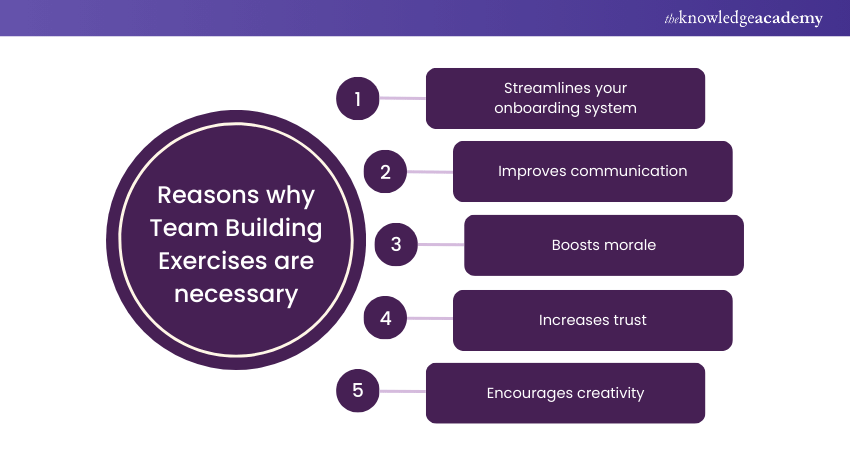
1) Streamlines your onboarding system
Having fun while introducing fresh hires to coworkers and the corporate culture is an excellent idea. New hires get a look at how coworkers engage with one another personally. They quickly realise how simple it is for Managers and employees to communicate.
These incidents show how an organisation values employees' quick integration into teams. New employees become familiar with the job description more quickly and in a less formal environment when the silence is broken in an enjoyable manner.
2) Improves communication
In the business, effective communication skills are a great asset. When employees have the necessary knowledge, the workplace is efficient. When methods of communication fail, productivity and teamwork can be affected.
Team communication is one of the goals of Team Building Exercises. Colleagues can learn the basic rules of communication by collaborating on projects.
3) Boosts morale
When their personal lives are taken into consideration, employees feel valued. An organisation conveys a message when it plans a Team Building activity. It demonstrates how management takes into consideration employees' talents, interests, and experience.
When their welfare is prioritised at work, employees are more likely to be motivated. These activities also help people feel more confident in carrying out responsibilities. The way Team Building Exercises are managed by colleagues teaches them to depend on each other.
4) Increases trust
Increasing trust among team members is important step in Team Building. By engaging in activities that require collaboration and communication increases trust among team members. As trust grows among team members, individuals feel more comfortable in sharing ideas, giving feedback and taking risks. Finally, it leads to improved teamwork and productivity.
5) Encourages creativity
Participants in Team Building Exercises become more creative as a group. People are motivated to think creatively and explore new ideas when they engage with tasks which challenge traditional thinking and encourage creative problem-solving. The organisation's creativity is encouraged by this creative exploration.
What are the types of Team Building Exercises?
Team Building Exercises are of various types. Each of these is designed to address specific areas of team dynamics. They can be categorised into icebreakers, communication, problem-solving, trust-building, and fun and engaging exercises. Let us look at some fun Team Building Exercises:
a) Icebreaker exercises
There are some ice-breaker exercises that you can follow or you can ask your organisation to follow to have a stronger team bonding:
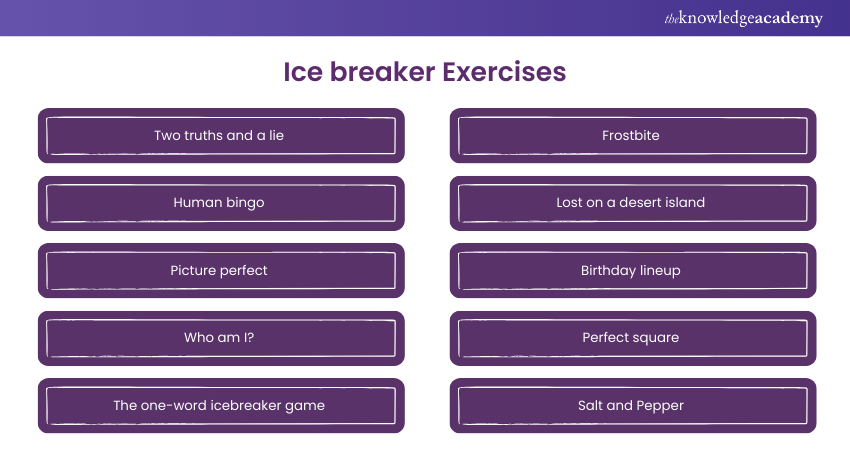
1) Two truths and a lie: In this exercise, each participant presents three statements about themselves, two of which are true, and one is a lie. The rest of the team members then guess which statement is false. This game is a perfect way for team members to learn some interesting facts about each other. It fosters a sense of familiarity and camaraderie.
2) Human bingo: In Human bingo, each participant receives a bingo card filled with unique characteristics, hobbies, or experiences instead of numbers. Participants have to mingle and find team members who match the attributes on their cards. This involves encouraging interaction and better understanding each other's backgrounds and personalities.
3) Speed networking: This exercise is especially useful for large teams or organisations. Participants have a short, predetermined amount of time to introduce themselves and share something interesting before moving to the next person. This allows team members to interact with individuals they might not regularly work with. As a result, it broadens their internal network.
4) Picture perfect: This activity involves participants describing a picture to their team members. These members then recreate the image based solely on the description. It's a fantastic way to highlight the importance of clear communication and bring out the creative side of team members.
5) Who am I?: In this game, each participant sticks a post-it note with the name of a famous person on their forehead. They then ask yes/no questions to guess their identity. It's a fun way to start a meeting and gets people into a problem-solving mindset.
6) The one-word icebreaker game: The one-word icebreaker game requires a group or groups made of 4-5 people. Within that group, each member is asked to give a one-word descriptor of a work event. For honest conversation, each group has a few minutes to discuss the reasons behind their chosen word.
After discussions, each group will settle on a chosen word to be shared with other groups. When these words are shared, they will prompt open discussion between the groups. This game provides an informal avenue to learn employee thoughts on an aspect of work. This could be a new policy, company culture, or even the methods of a supervisor.
7) What do we have in common?: The common game can be carried out in person or as virtual Team Building. Over the course of a company lunch, or zoom call, members from different groups are placed in units. Within these units, members are to find out between 5-10 things they share in common. It could be a favourite pizza flavour or a shared love for classical music.
Considerable probing takes place to learn about shared experiences. This will push colleagues to learn a large amount of information in a short period. Personal employee engagement in large organisations can be challenging. When departments and personnel rarely interact, a simple exercise can improve relations.
8) Frostbite: This game will require a team leader and subordinates. Also necessary are sticky notes or post-its, toothpicks, thick cardboard boxes, and a fan. Ignoring the office or other environment, participants pretend to be in the Arctic. They are being guided on an arctic exhibition which they need to survive. Team members are to build the shelter for their survival. In a democratic setting, teammates elect a leader to guide them through this activity.
The team lead will give instructions on how this structure should be erected. He is unable to take part due to frostbite suffered during the journey. While blindfolded, team members build the structure using the leader's verbal instructions. This task will teach supervisory abilities and instruction-taking skills. Members also learn the value of time management during tasks.
9) Lost on a desert island: This game is a Team Building and get-to-know-you icebreaker. Given the scenario that everyone is lost and stranded on a deserted island, each person describes one object that they would bring to the island and why. The recommended group size is medium, although small and large group sizes are possible too.
An indoor setting is ideal. No special props or materials are required, making it easy to play. This icebreaker works well for any age, including adults and corporate settings. Lost on a Deserted Island is a valuable Team Building activity that also helps people share a little about themselves.
10) Birthday lineup: Explain that the goal of this activity is to line the group up according to their birthdays (month and day) without talking. The game is played by using signs and symbols to interact. The line should begin on January 1st and end on December 31st.
Allow the group to work together silently to complete the task. Once they believe they are finished lining up, start with the beginning of the line and ask participants to say the month and day in which they were born out loud. This exercise reveals how well teammates can coordinate on tasks.
11) Perfect square: In this activity, team members have to form a perfect square while blindfolded. Get everyone to stand in a circle while holding the rope. Once the circle is formed, they can lay the rope on the floor. Each participant then puts on their blindfold and has to take five steps backwards. The task is to work together to form a square while blindfolded.
Once the team is blindfolded, they can begin the activity. The activity ends when the team thinks that they have formed a square. Participants then take off their blindfolds and see the final result. This will offer practice in effective communication and interaction among partners.
12) Salt and Pepper: In the game "Salt and Pepper," participants work in pairs and are given labels such as "peanut butter and jelly" or "macaroni and cheese." Participants in "Salt and Pepper" work in pairs and are given labels such as "macaroni and cheese" or "peanut butter and jelly." The names of the pair have been attached to every person's back. They get their allocated label by answering five yes/no questions.
The pairs then find one another. In order to disclose their identities, participants must properly interact and employ critical thinking, which encourages teamwork and camaraderie within the group. This activity promotes creativity and communication.
Enhance your Team development skills with our Team Development Training - sign up now!
b) Communication exercises
Team Building Exercises also include communication exercises. They are designed to improve and strengthen open dialogue among team members. These kinds of Team Building Activities help enhance Active Listening Skills, verbal and non-verbal communication. This also increases the ability to articulate ideas effectively, which in turn fosters better team understanding and minimises misunderstandings. Here are some examples:
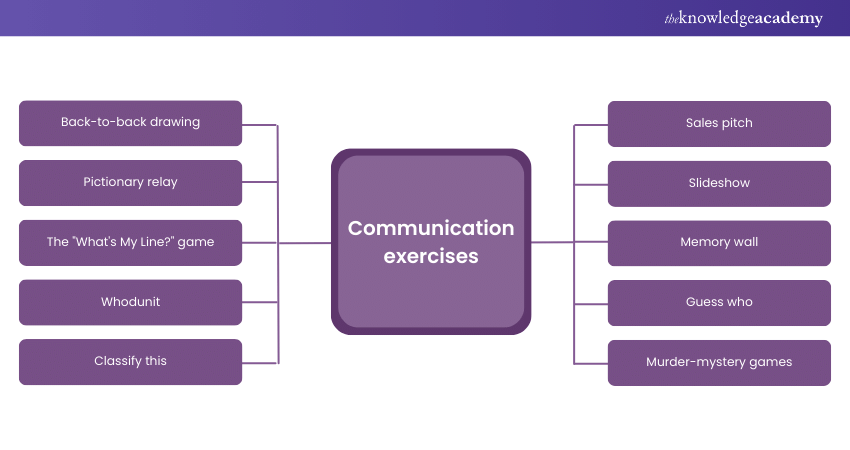
1) Back-to-back drawing: In this exercise, pairs sit back-to-back. One person is given a picture which they describe to the other person, who attempts to draw it based on the description. This activity underscores the importance of clear and detailed communication.
2) Pictionary relay: This type of Team Building Exercise requires one team member to draw a given word while the others guess what the word is. This emphasises the role of non-verbal communication and shows how different interpretations can lead to confusion if not clarified.
3) Blindfolded obstacle course: One team member is blindfolded while others guide them through an obstacle course. This activity builds trust and highlights the importance of effective communication and listening skills.
4) The "What's My Line?" game: Team members write down an unknown fact about themselves on a piece of paper. These are then read aloud; everyone else must guess who wrote each fact. This encourages open communication and deeper understanding among the team.
5) Whodunit: This game requires a small group of people to write a note, which is one interesting thing they’ve done. These include activities like the past winner of a food-eating competition, skydiving, etc.
This note is then placed into a container that other members of the group pick from.
Teammates are required to guess which colleague fits the bill of the note selected. They will give reasons, opening discussions as to why this may be correct or wrong. This game offers great insight into the extracurricular activities' teammates engage in.
6) Classify this: For this one, you'll collect a number of items that are different from one another. This can be office supplies, toys, games, kitchen utensils, etc. You'll need around 20 objects for each group.
With the groups formed, have each one try to group the objects together into four different categories. They can come up with the categories they want but each object must belong to one. They'll write their grouping on a sheet of paper.
After the time is up, a spokesperson for the team will read their groupings and explain why they came up with that result. The purpose of the game is to have an idea of how each team member sees things differently and how one object can be grouped in different ways depending on the point of view of the person.
7) Sales pitch: Team members can engage in quick reasoning through a sales pitch. This exercise follows each person as they select one item from the office. For the next 15 minutes, they'll craft a sales pitch promoting it.
Each object will be given a name, logo, and motto. They’ll also give a whiteboard presentation explaining why their fountain pen, sheets of paper, or office pin should be patronised.
This builds collaboration between team members.
8) Slideshow: As part of a communication exercise using slideshows, let team members create a quick presentation on any random topic. A different topic and ten minutes are given to each participant to prepare their presentations.
They then make a presentation to the group, promoting participation and clear communication. This exercise improves the ability to communicate complicated ideas in a simple manner, promotes creativity, and improves public speaking abilities.
9) Memory wall: Give each player markers, paper, tape, and a flat surface to draw on. Make sure you have usable wall space for display purposes. Ask the players to survey the other players in the room and take 10–15 minutes to write down positive, stand-out memories of working together, learning from each other, or participating in some way in organisational life.
Tell them they can take 20–30 minutes to draw these “memory scenes.” They can partner with any person involved in a memory to conjure up the details of that memory—visually or contextually.
When drawing time is up, ask the players to tape their scenes on the wall, forming a visual “memory cloud.” As the meeting leader, first, ask for volunteers to approach the wall and discuss memories they posted and want to share. When you’ve run out of volunteers, approach memories on the wall that catch your eye and ask for the owner to share the story.
This game highlights the employee contributions and celebrates their accomplishments.
10) Guess Who: "Guess Who" is a Team Building activity in which participants are divided into groups and given descriptions or clues about well-known people from a variety of fields, including historical, fictional, or popular persons. Using their combined ideas and thoughts, each team works together to figure out the person's identity based on the information that has been provided.
This allows them to arrive at the right conclusion. As teams collaborate to overcome the problem, this game develops critical thinking, cooperation, and Team Building Skills while also encouraging a sense of camaraderie among participants.
10) Murder-mystery games: Murder mystery games give an exciting opportunity for Team Building, with players taking on various roles within an engaging story. Each member of the team works together to solve puzzles, collect information, and figure out who the culprit is.
As the group works to achieve the same goal, this engaging game encourages critical thinking, partnership, and communication. In spite of improving problem-solving abilities, it also strengthens relationships between individuals, which makes it an exciting and effective method of improving team dynamics in an enjoyable environment.
12) Plot me out: A Team Building game called "Plot Me Out" is aimed at fans of television and movies. An observer explains the plot of a well-known movie or television show during the activity. Teams of participants compete to correctly identify the title based on the description.
Through talks and collaborative predictions, this activity not only creates a humorous and entertaining environment for team members to relax in, but it also promotes involvement and enhances communication skills, building a sense of togetherness between colleagues.
Discover the secrets to successful team development with our Team Development Training- sign up today
c) Problem-solving exercises
Problem-solving exercises are tailored to stimulate critical thinking, creative problem-solving skills, and collaborative decision-making among team members. These activities are essential in honing a team's ability to tackle complex tasks and adapt to unforeseen challenges in the workplace. Here are some examples:
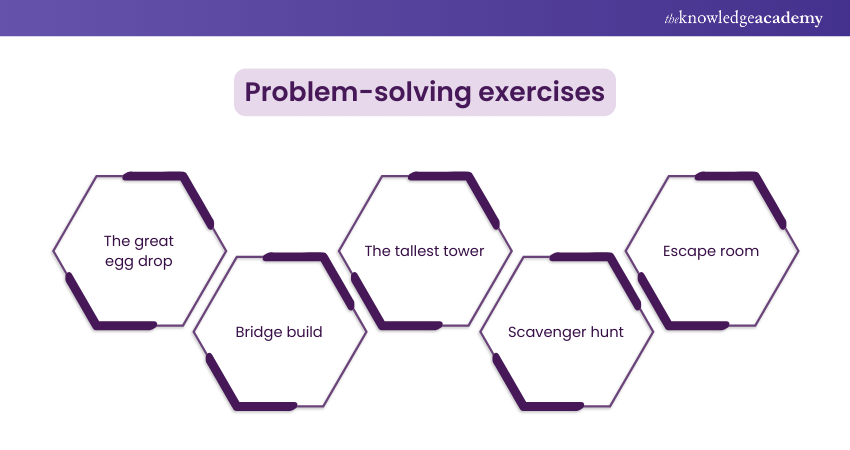
1) The great egg drop: Teams are given various materials and are tasked to create an obstacle to prevent an egg from breaking down when dropped from a considerable height. This exercise encourages creative problem-solving and fosters a sense of shared achievement.
2) Bridge build: Teams are given identical sets of materials and must construct a bridge supporting a specific weight. This task emphasises the importance of planning, collaboration, and efficient resource utilisation.
3) The tallest tower: Teams compete to build the tallest freestanding tower with a limited set of resources. This activity encourages creative thinking and tests the team's problem-solving and collaboration abilities under pressure.
4) Scavenger hunt: A scavenger hunt can be organised either virtually or physically. Teams must work together to find items or complete tasks listed in the scavenger hunt. This is one of the most interesting Team Building Exercises as it improves problem-solving skills and encourages team collaboration. It can also be a fun way to learn more about each other or the company.
5) Escape room: Whether conducted in person or virtually, escape rooms are fantastic problem-solving exercises. Teams must work together to solve puzzles and escape from a locked room within a time frame, fostering quick thinking, cooperation, and a sense of shared victory.
6) The marshmallow challenges: Team members are given 20 sticks of spaghetti, one marshmallow, plus one yard of string and tape. Using these materials, each team is to create the tallest freestanding structure possible. When the structures are built, players determine the winner using a measuring tape. During this activity, team members learn the strong effects of collaboration.
Boost your problem-solving skills and lead your team to success with our Problem Solving Training .
d) Trust building exercises
Trust-building exercises are essential in fostering a sense of mutual respect, reliability, and security among team members. These Team Building Excercises are created to enhance the understanding of each other's strengths and weaknesses, establish transparency, and create a safe environment for open communication and collaboration. Here are some examples:
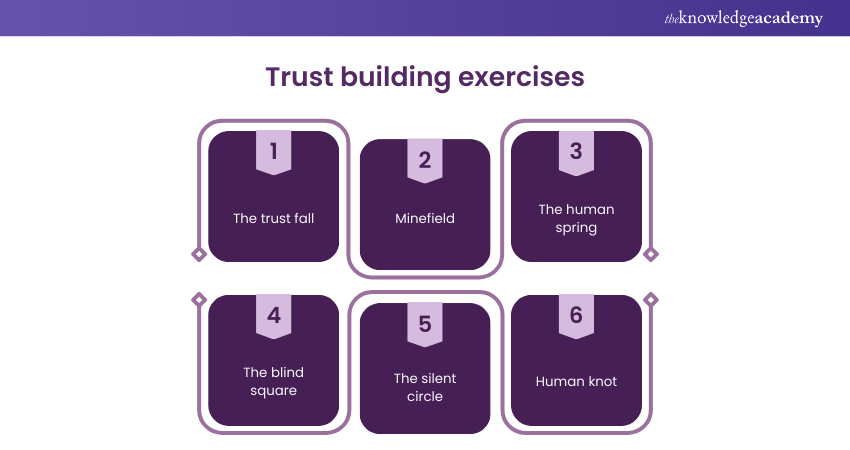
1) The trust fall: A classic exercise, the trust fall requires team members to fall backwards, relying on their teammates to catch them. This physically demonstrates the importance of trust within the team.
2) Minefield: In this activity, certain areas of a room or open space are designated as 'mines.' Blindfolded team members are guided by their teammates through the minefield using only verbal instructions. This helps build trust and effective communication.
3) The human spring: Two team members stand facing each other, reach out, and press their palms together. They then lean towards each other and push back to the original position. This exercise helps build trust as teammates rely on each other for balance.
4) The blind square: In this activity, team members are blindfolded and instructed to form a perfect square with a rope. The task requires trust in each other's directions and highlights the importance of working together for a common goal.
5) The silent circle: A team member stands in the middle of a circle blindfolded while the others quietly move around. The person in the middle has to point to where they believe a team member is, who then confirms. This activity promotes trust in intuition and team members.
6) Human knot: This game is ideal for large teams and can really push people outside of their comfort zones. While gathered in a circle, team members join right and left hands with a person opposite them. Teammates cannot hold hands with the person next to them.
When all members have their hands in a knot, the game requires this knot to be untangled without releasing their hands. It requires communication and careful instruction to be successful. The first team to stand in a perfect circle with hands joined wins.
Maximise your team's efficiency with our Productivity And Time Management Course.
Fun and engaging exercises
Fun and engaging exercises are crucial in breaking the monotony of daily work, fostering positive relationships, and boosting team morale. They incorporate elements of enjoyment and play, which not only motivate team members but also promote creativity, reduce stress, and enhance overall team bonding. Here are some examples:
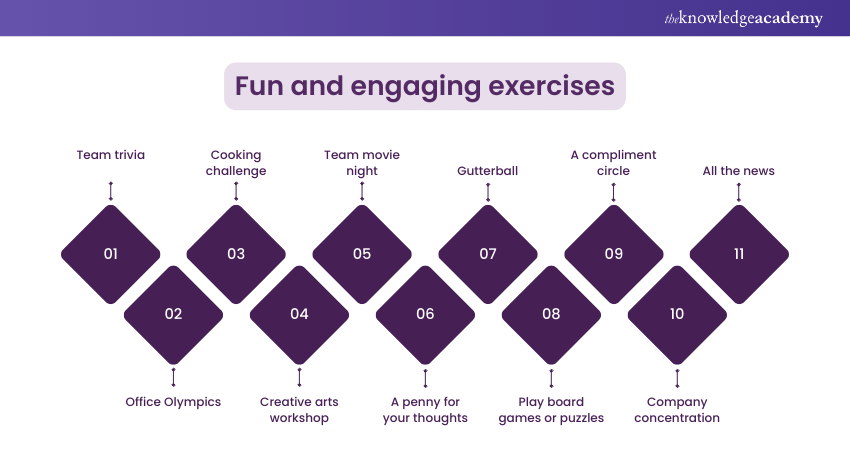
1) Team trivia: A friendly round of trivia can be an engaging way for team members to unwind. This can be work-related to test and enhance knowledge or entirely unrelated topics for fun and relaxation.
2) Office Olympics: This could involve various fun games like chair races, paper aeroplane making, or desk ping pong. Not only do these activities lighten the mood, but they also foster healthy competition and teamwork.
3) Cooking challenge: Similar to popular TV shows, teams can have a cook-off with mystery ingredients. This exercise can bring out hidden talents and provides a unique platform for team members to collaborate and create something enjoyable together.
4) Creative arts workshop: Activities like painting, pottery, or jewellery making can provide a creative outlet for team members. This helps in encouraging them to explore new skills and share a different side of themselves with their colleagues.
5) Team movie night: A simple yet effective way to bring teams closer, a movie night can be organised at the office or virtually. This shared experience provides a relaxed environment for team members to bond and engage in casual discussions.
6) A penny for your thoughts: This game provides an interesting spin on icebreakers. It requires pennies or coins with listed years and a container to place them in. With the coins in the container, members of the group will reach in and identify the year inscribed.
The colleague will then share a personal event from that time. This activity can create a bond between teammates. Colleagues build relationships when they learn personal facts about team members.
7) Gutterball: Each participant gets one gutter. The object is to move the marble from point A to point B without dropping the marble. Generally, as the facilitator you can make the pathway to point B as easy or as difficult as you like, depending how well your group works together. You can take them over obstacles, downstairs, around trees, etc. Get as creative as you like.
8) Play board games or puzzles: Engaging in board games or puzzle games is an effective Team Building activity that fosters collaboration, communication, and problem-solving skills. By working together to solve challenges and achieve common objectives, team members build rapport and trust, strengthening the overall team dynamic.
9) A compliment circle: Gather all team members in a circle, ensuring everyone can see and hear each other. Choose one person to begin with. They give a genuine compliment to the person on their right, starting with phrases like "I appreciate..." or "I admire...". After receiving a compliment, the next person in the circle gives a compliment to the person on their right. Once everyone has had a chance to both give and receive compliments, consider rotating positions or repeating the activity to maximise its impact.
10) Company concentration: This game is a work-friendly version of Concentration. Cards containing names and images of colleagues may be made. Cards may also have company facts like the logo, mission statement, motto, values, etc. Each player then selects two cards to see if they match. The quickest to match the cards wins.
Company concentration is a vital aspect of Team Building, fostering unity and cohesion among team members. By aligning everyone's focus towards common goals and objectives, company concentration ensures that every individual understands their role within the team and works collaboratively towards shared success.
11) All the news: In groups of 3-6, team members in a department share headlines of potential feats. These headlines are shared as in a newspaper article. As a unit or through a spokesperson, the measures required to reach this are reviewed. This may be played by in-office workers and members of remote teams. This game encourages team members to get excited about projected goals.
Learn more about managing remote teams effectively with our Managing Remote Teams Course- join now!
Conclusion
Team Building Exercises are an indispensable part of creating a thriving, collaborative, and efficient work environment. They serve to foster better communication, enhance problem-solving abilities, build trust, and, most importantly, make the workplace more enjoyable. A team that can work together will succeed together.
Elevate your management skills and unlock your team's potential with our Management Training
Frequently Asked Questions

Team Building Exercises promote creativity, cooperation, and trust between team members. They increase productivity and teamwork throughout the organisation, boost communication skills, and create a feeling of togetherness.

For remote teams, virtual escape rooms, scavenger hunts, murder mysteries, and truths-and-lies games are some of the Team Building Exercises.

The Knowledge Academy takes global learning to new heights, offering over 30,000 online courses across 490+ locations in 220 countries. This expansive reach ensures accessibility and convenience for learners worldwide.
Alongside our diverse Online Course Catalogue, encompassing 17 major categories, we go the extra mile by providing a plethora of free educational Online Resources like News updates, Blogs, videos, webinars, and interview questions. Tailoring learning experiences further, professionals can maximise value with customisable Course Bundles of TKA.

The Knowledge Academy’s Knowledge Pass, a prepaid voucher, adds another layer of flexibility, allowing course bookings over a 12-month period. Join us on a journey where education knows no bounds.

The Knowledge Academy offers various Management Courses, including Team Development Training, Problem Solving Course, Managing Remote Teams, Personal and Organisational Development and Introduction to Managing People. These courses cater to different skill levels, providing comprehensive insights into Team Leadership.
Our Business Skills Blogs cover a range of topics related to Management Courses, offering valuable resources, best practices, and industry insights. Whether you are a beginner or looking to advance your Business skills, The Knowledge Academy's diverse courses and informative blogs have you covered.
Upcoming Business Skills Resources Batches & Dates
Date
 Management Training for New Managers
Management Training for New Managers
Fri 5th Jul 2024
Fri 23rd Aug 2024
Fri 18th Oct 2024
Fri 6th Dec 2024









 Top Rated Course
Top Rated Course



 If you wish to make any changes to your course, please
If you wish to make any changes to your course, please


